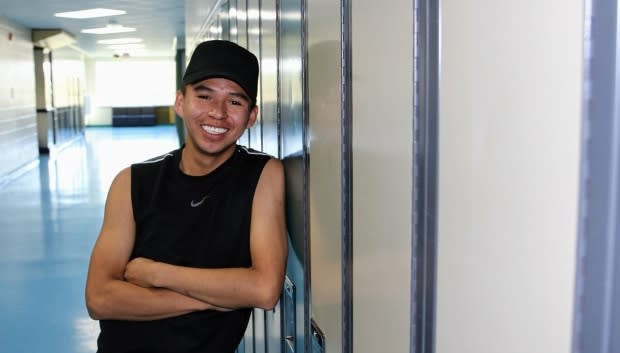Focus on Cree culture paying off in Maskwacis schools
Maskwacis student Donavan Buffalo is determined to graduate from high school and pursue a career in carpentry.
"I just really want to push myself," said the 16-year-old, who lives in the Indigenous community south of Edmonton.
"My goal is to become a carpenter and I really want to make that goal come true."
He's seen first-hand how a change of culture at his school helps young people succeed.
"A lot of people are starting to realize that school is really what you need nowadays," said Buffalo, a Grade 11 student at Nipisihkopahk Secondary School.
"I'm trying to push others to reach for the end of the year, do what they need for their future."
Buffalo is one of the 2,144 Maskwacis students benefiting from a new education structure that focuses on Cree values and school engagement.

The community's four First Nations, Ermineskin Cree Nation, Louis Bull Tribe, Montana First Nation and Samson Cree Nation, united in November 2017 to form the Maskwacis Education Schools Commission.
The amalgamation enabled the communities to pool resources and knowledge, leading to a uniform teaching approach at 11 schools.
"We have an opportunity to shape the direction of education in the ways that truly work for our children," said Shauna Bruno, chairperson of the board of governors.
Cree values such as wâhkôhtowin, or kinship, are woven in every aspect of school life, Bruno said.
"We all have a responsibility in ensuring our students receive a strong foundation in traditional Nehiyaw (Cree) teachings," she said.
Improved high school retention
While poor attendance continues to be a challenge at the high school, staff are using the concept of wâhkôhtowin to improve student engagement, said principal Keith MacQuarrie.
"We're really building that sense of connection between the people and the building, the staff, the students and community," MacQuarrie said.
The first school year under the new vision yielded promising results, with 85 per cent of Grade 7 to Grade 12 students at Nipisihkopahk completing the school year, compared to 45 per cent the year before.
The schools provide breakfast and lunch for every student, giving them the foundation they need to learn, MacQuarrie said.
Students also learn the Cree language and participate in traditional ceremonies, like smudges and sweats.
"I think it's a huge part of having students feel safe and cared for," MacQuarrie said. "When students feel safe and cared for, then they want to be at school."
Buffalo said taking part in the school's traditional drumming group gives him a deeper appreciation of his Cree identity.
"It just gives me self-respect," he said. "It makes me feel like I make my family proud."
He's noticing more and more students taking an interest in the school's cultural aspects.
"New kids are coming in every time we drum and that's pretty cool to see because they're actually trying to take the time to learn our culture."
Early literacy results
The new structure also emphasizes literacy.
"Reading is how they can explore the world, research, and know more," said Debbie Michaels, Ermineskin Elementary School principal.
"They need those foundational pieces and it's a barrier for kids who don't have that."
The school has been part of a national literacy project since 2016 through the Martin Family Initiative, a charity dedicated to improving literacy results at First Nation schools.
Teachers received extra professional development and shared that knowledge with their colleagues, Michaels said.
"It has created an opportunity for a lot of educators to come together to refine and improve current practices," she said.

Last year's Grade 6 provincial testing results were encouraging, with 94 per cent of students in the schools receiving acceptable or excellent levels in writing.
Reading levels however still need work, Michaels said, with only 54 per cent of students reaching acceptable or excellent levels.
Educators are hoping that the progress made within the school system will trickle down into the community.
"When you have healthier children in your community, it leads to a healthier community overall," Bruno said. "That has that ripple effect, even toward neighbouring communities and into the world."

